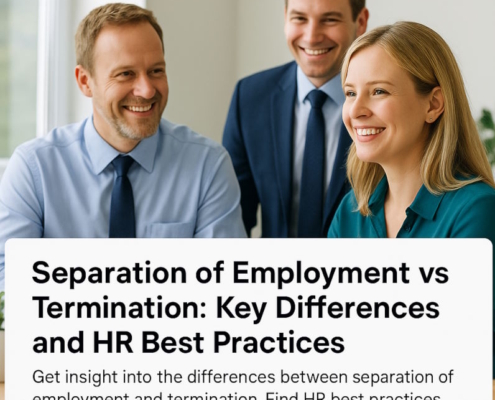What are KPIs for HR?
Without measuring the outcomes of your effort, managing people cannot get any better. If you do not know what constitutes “good performance” or how to quantify it, how will you know if you are performing well?
Dr. William Edwards Deming was a prominent American statistician and management consultant. His most well-known phrase is perhaps, “Without data, you’re just another person with an opinion.” Key performance indicators, or KPIs, are unquestionably essential to maximizing the use of employee and worker data.
Thus, how will you be able to gauge your level of success in business if you don’t track your HR performance? Performance indicators are necessary to gauge success.
In this article, we will delve into the specifics of KPIs in HR. We’ll go over their definition and applications and provide you with a blueprint for making them yourself!
First, let’s study key performance indicators (KPIs) to address this topic. KPIs are metrics used in strategy. A KPI is a measurable indicator that assesses how well a company accomplishes important goals. This is not to say that every measurable item in HR is a KPI. KPIs are limited to indicators that are directly related to the organizational plan.
HR measures known as HR key performance indicators (HR KPIs) are used to determine how HR benefits the rest of the company. Accordingly, an HR KPI assesses how well HR is implementing the company’s HR strategy.
The organizational strategy comes first in HR strategy. In other words, HR KPIs reflect HR’s organizational performance because they are developed based on HR outcomes relevant to meeting business objectives. The Balanced Scorecard is frequently used to create these company objectives.
To effectively align HR strategies with broader business goals, integrating business performance metrics into HR KPIs is crucial.
Let’s take an example to show you how this works.
The Dodgers are an enterprise attempting to innovate in a highly competitive market. As a result, the board of directors decided to reduce expenses everywhere but in the product innovation division. How will this objective be converted into HR KPIs?
HR is not the only department that needs to make financial savings. For instance, this reduction might be applied to the cost of hiring. It is necessary to lower the cost to $400,000. It is currently at $500,000. The KPI in this instance is “Recruitment cost in dollars,” with a target of $400,000 and a current score of $500,000.
“Innovative behavior,” gauged by the yearly engagement survey, can be the second HR KPI. Right now, it has a 10-point rating of 6.2. The cutoff point is 7.5 or above. It is going to take a lot of work to do this!
HR might add several KPIs to accomplish a certain company objective. These KPIs can all be divided into more manageable objectives.
It is ideal if these KPIs align to implement the HR strategy. However, they do occasionally clash.
For example, you are faced with a tough decision if you need to reduce expenses in your budget for learning and development but still want to encourage innovation. The strategic challenge is to cut your training spending while still fostering creativity. This is an excellent illustration of how HR KPIs support HR in achieving its strategic goals and helping the rest of the organization achieve its goals.
A list of Key Performance Indicators for HR
Many web articles include tens, sometimes even close to one hundred, key performance indicators. Don’t be duped: most of these are straightforward HR metrics that shouldn’t be monitored because they frequently conflict with corporate objectives.
A few examples of what HR KPIs are NOT can be found below:
- Average expense for an interview
- Average period of placement
- Average duration of employment
- Average income
- Average amount of time spent on training for each employee
- Average number of days off
- Average amount of unpaid leave for each employee
- Average retirement age
- Cost of benefits as a proportion of income
- HR-to-FTE ratio
- Employee training satisfaction
How come these aren’t KPIs? They provide no information regarding efficacy. For instance, do we require 1.5 or 1 HR employee for every 100 employees? The HR-to-FTE ratio alone cannot answer that question.
To put it briefly, none of these measures will help the firm achieve its goals. Each company uses its own set of KPIs. Since each firm is unique, the KPIs should be considered.
The following list contains 17 sample KPIs that you may add to your HR dashboard:
- Absenteeism rate: The number of working days an employee misses is often divided by the total number of work days in the company to determine the absenteeism rate.
- Cost of absence: The total expense of absence is determined by adding the costs of managing absence, employee compensation, and replacement costs. This KPI is particularly important for European nations with robust labor unions and high worker protection standards.
- Benefits fulfillment: A survey about worker engagement is typically used to gauge satisfaction with employee perks. These have the potential to significantly lower staff turnover.
- Employee productivity rate: However difficult to compute, this measure provides insight into the potential for expansion in terms of human capital production. It frequently has to do with speed or accuracy.
- Employee satisfaction: Employee engagement and attitude surveys are used to calculate the employee satisfaction index. One typical reason for employee turnover is dissatisfaction.
- Employee engagement index: Opinion or engagement surveys are another way to gauge employee involvement. Strong employee engagement predicts increased productivity, improved customer service, decreased attrition, and many other relevant and favorable results.
- Employee Innovation Index: Engagement or attitude surveys are another way to gauge innovation. An increasingly important factor in the success of businesses is innovation. HR’s responsibility is to facilitate this innovation.
- Internal promotion rate: The number of senior roles filled by internal promotion divided by the total number of higher-level positions filled yields the internal promotion rate KPI. Internal hires frequently adjust to the role more quickly, lower the chance of a poor hire, and remain in it longer.
- The Net Promoter Score: A Net Promoter Score (NPS) is a great tool for gauging how likely a customer is to refer a product or company to a friend or colleague. The NPS of HR can be used to determine employee satisfaction with the department’s offerings. Using the NPS, you can also gauge how much individuals advocate working for the company. NPS may be a useful HR KPI based on your strategic objectives.
- Workforce expense: The workforce cost as a percentage of total costs is calculated by dividing the workforce cost by the total expenses incurred by the company. Although it isn’t used frequently, this KPI could be beneficial for improving automation and robotics within a company or cutting costs.
- Quality of recruitment: The proportion of newly hired employees that receive a positive performance assessment score from their manager is known as the quality of hire. The quality of a hire is a good indicator of how well HR finds and chooses applicants. The business can reach its strategic objectives when a high-quality hiring rating is consistently maintained.
- Turnover rate: Because excessive turnover can be highly expensive, turnover is both a frequent statistic and a crucial KPI.
- Rate of involuntary turnover: Not all employee turnover is chosen. This represents the proportion of employer-led resignations to all resignations.
- Rate of voluntary turnover: The percentage of employee-led resignations to all resignations is known as the voluntary turnover rate.
- Rate of unwanted turnover: Not all turnover is bad. When poor performers quit, it’s usually a good thing. This represents the percentage of all workers who left who were good performers.
- Effectiveness of training: For training to accomplish its objective(s), it must be effective.
- The 360-day or 90-day quit rate: This is the number of new hires departing within three or twelve months. Even a double-digit percentage is concerning. HR is responsible for hiring the proper candidates. If this isn’t done, the organization’s effectiveness will suffer quantifiably. This is a crucial KPI for recruiting.
Qualities of effective HR KPIs
You may now create key performance indicators for human resources and distinguish between metrics and KPIs. The unanswered question is, “What qualities distinguish effective HR KPIs?”
Eckerson lists several qualities of “good” KPIs in a 2009 paper.
- Sparse: Your main focus should be just a few HR KPIs. There’s a reason these are referred to as key performance indicators. Leave the others out and concentrate on the important ones. The overall principle still holds: the less, the better.
- Drillable: It must be possible to drill down to specifics. Why aren’t we spending enough on recruitment? Which groups are the most expensive to hire? By going deeper, you may more accurately forecast your future success and identify areas needing improvement.
- Straightforward: Users need to understand the KPI. It is difficult to focus on and discuss if it is not simple.
- Practical: Since HR can affect these KPIs, it concentrates on those linked to HR outcomes. Sales performance and income are not HR’s responsibility. Pay attention only to the KPIs whose results you can influence.
- Owned: Keeping with the earlier ideas, KPIs require an owner. If the owner meets the goal, they will be rewarded; if not, they will be held accountable. A high-ranking management team member, such as a manager or department head, is most likely the owner of an HR KPI.
- Correlated: The intended result and the KPI should be connected. The HR KPIs must be connected to these business results when discussing business aims. Bringing on better performers won’t save you money straight. While hiring high performers is important, you shouldn’t let this take precedence over cost-cutting measures if the business needs to stay afloat. Perhaps you can cut your recruitment expenses by thirty percent without lowering the hires’ caliber. This is more significant since it advances the business’s strategy. According to Griffin (2004), there needs to be a clear connection between KPI and goals, as well as between goals and objectives and strategy.
- Aligned: We have already talked a little about aligning HR KPIs. KPIs shouldn’t conflict with one another.
The following is a simplified framework that outlines the previous points. Hursman (2010) identified the alternative as the popular SMART acronym. This stands for:
Specific
Measurable
Attainable
Relevant
Time-Bound
A clear understanding of these standards will help you develop the appropriate HR KPIs you require to succeed. A SMART KPI is not the average length of service. Though readily quantifiable and achievable, it lacks intelligence, relevance, and timeliness. Employees’ tenure at a company is not a good indicator of their effectiveness, productivity, or creativity. It is unrelated to the company’s overarching requirements and objectives.
The internal promotion rate, on the other hand, is a SMART KPI. It’s shrewd since it shows how workers advance and enhance their abilities. It is time-bound, relevant, quantifiable, and achievable. Such a KPI will display the number of employees who advance inside the business.
KPIs: leading versus lagging
The next difference to discuss is leading versus lagging KPIs. The researchers who developed the Balanced Scorecard, Kaplan and Norton (2007), describe this distinction in their study.
A leading indicator predicts future events and causes. These signs come before something happens. For labor costs, productivity is a primary key performance indicator.
A lagging indicator refers to earlier trends and outcomes, reflecting previous KPI results. If productivity is a leading HR KPI, the sickness rate will be a lagging HR KPI for labor costs. An additional lagging KPI to consider would be the labor cost per employee.
When supporting employees’ qualification is the company goal, what would be the appropriate leading and lagging indicators? This is important, for instance, if providing qualified services requires ongoing (re)qualification.
Time to proficiency could be a leading indicator in this situation since trained personnel apply their knowledge more quickly. This will support an organization’s overall creativity and productivity. The percentage of workers who finished the qualification could be the lagging indicator.
These examples demonstrate that leading indicators are frequently less accurate but provide fascinating information about a KPI’s continuous performance. More accuracy is obtained with the lagging indicator, but only after the event.
If these KPIs are included, creating a scorecard to track past performance and predict the future will be easier.
Developing a scorecard for HR KPI: An actual company example
As we’ve just discussed, not every KPI is important or will help with comprehending HR performance. In this section, we will provide an example of how to make an HR KPI template for a hiring department. This example is based on an actual marine enterprise.
The maritime industry in the West is in rough waters. Large freighters and tankers are currently built in East Asia for significantly less money, whereas fifty years ago, most ships were produced domestically.
It was challenging for this US-based shipbuilding industry to compete with China’s inexpensive labor and steel. That meant a cost-differentiation plan was out of the question.
Considering that most of their present clientele was interested in their technological shipbuilding capabilities (mostly for smaller vessels at a much higher price point), this company decided to invest in technology and innovation.
Strategic objectives are seldom achieved alone. This sample company needed to reduce expenses while increasing innovation through more astute employment decisions:
- They had to lower the expense of hiring new employees.
- They wished to appoint better experts.
It can be difficult to develop reliable and beneficial HR KPIs for a company. When implemented correctly, however, they allow HR to boost company value significantly in a tried-and-true, data-driven manner. Using HR KPIs to set targets gives us a framework for improving decision-making and achieving strategic business outcomes.































